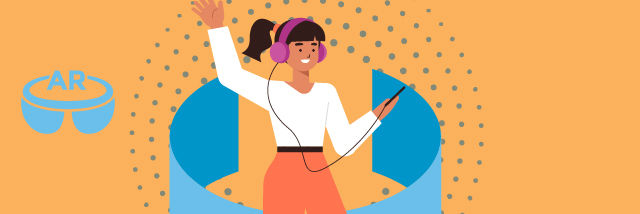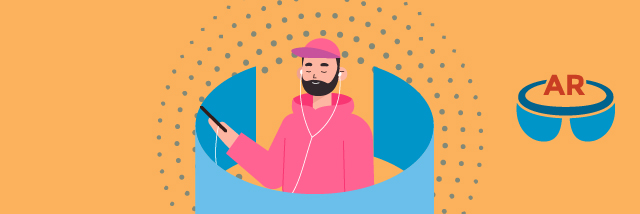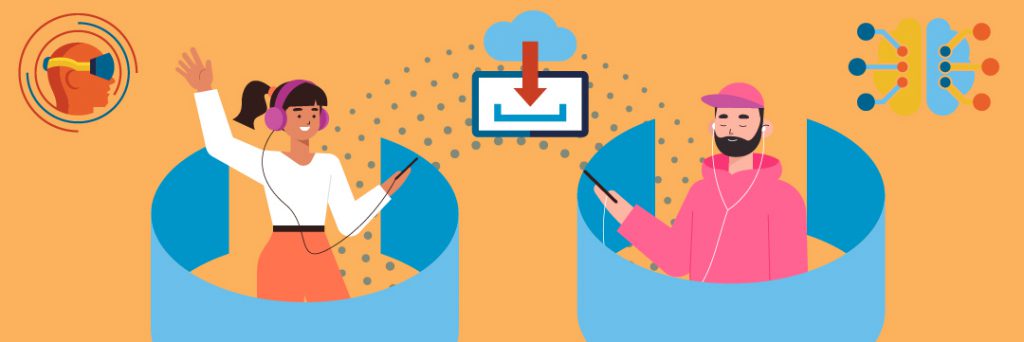3D audio is one of those things you see in fancy headphone boxes everywhere. “A revolution in sound!” or, “A truly immersive aural experience.” It all sounds well and good, but you may be asking yourself “What is 3D audio, anyway, and how can it help?” Well, you’ve come to the right corner of the internet, then.
3D audio is being increasingly leveraged in advertising to great effect. Some studies consistently show that it’s positively correlated with an increased intention to purchase, and long-term memory. If that doesn’t make you stop and take notice, then I don’t know what will.
But marketers aren’t the only ones that are happy about being able to use 3D audio. Audiophiles everywhere are practically salivating at the mind-blowing potential of this technology. It’s creating more opportunities for immersive, all-around experiences that blur the line between reality and fiction. If you’re all about crafting believable worlds, then that might be right up your alley.
Let’s not get ahead of ourselves, though. Today, we’re going to be discussing the origins, popular uses, and potential of 3D audio. We’re going to cover what it is, as well as its uses throughout different industries. I’ll throw in some examples to boot, so grab a good pair of Surround headphones if you’ve got ’em!
But if you prefer to watch a video instead, click here:
What is 3D Audio?
3D audio effects are complex sleights-of-hand that manipulate the capacities of speakers and headphones to produce the illusion of spatial sound. We normally receive audio in stereo from left and right channels. Three-dimensional sound takes things even further by making you believe sound comes from every direction.
We may only have two ears, but they actually pick up sound in a spherical pattern. 3D audio takes advantage of this omnidirectional pickup (also present in some microphones) by using a technique called HRT (Head Related Transfer Functions). This mimics the emanation of actual sound waves, which come from a point in 3D space. Even though the sound is still produced by two or more speakers (like in surround sound), we perceive it as if it were coming from different directions and distances. This maximizes the use of relatively few speakers, and tricks the brain into saying “hey, that came from over yonder!”.
In short, it’s all ways to cleverly deceive our auditory sense and convey an illusion of direction, proximity, and intensity. The most advanced technologies can also replicate the feeling of audio reverberating on floors, walls, and other surfaces. Some software can also convert binaural recordings (made with two microphones at different distances) to real-time 3D sound experiences for normal speakers and headphones.
3D audio, then, is a step in replicating our real-life experience of sound. It allows users to immerse themselves in an experience, which in turn becomes more memorable and lived-in than normal audio. This is fantastic for marketers, video game makers, filmmakers, and even e-learning course creators. It’s also the next frontier in creating even more lifelike virtual reality (VR) representations.

3D Audio and Memory
By allowing the user to feel where they are relative to the sound, they can create more realistic spaces. 3D audio can further enhance this uncanny feeling of being somewhere else. This, in turn, makes the whole experience easier to remember and recreate.
Just imagine these two ads, for reference:
Ad #1 (Normal Audio)
Announcer: Come on down to the next Lollapalooza, where the best bands gather for a three-day music experience!
The sound of music comes on. Audio samples of different bands fill your ears.
Announcer: all-day wristbands and VIP passes available! An unforgettable music gathering! Tickets available online through Ticketek!
*end of ad*
I can’t really tell you how many times I’ve heard ads like that on the radio or watching YouTube. While they get the point across, you don’t really get anything from it that you probably haven’t already gotten from banners, social media, and other ads. Big festivals like that tend to advertise in a multitude of spaces, and their programmatic ads make sure you’re bombarded with the same information over and over. Even if you hadn’t, this audio ad would be informative but not particularly exciting.
Let’s contrast it with the second ad.
Ad #2 (3D Audio)
There’s the excited chatter of a crowd all around you. Voices fade in and out as people brush by, talking animatedly about the band. Things like “Did you watch their Chicago performance? Perfect setlist choice!” and, “I hear they always play exactly on the hour, 10 seconds left!”.
As people continue talking, suddenly a guitar comes on. A strum of a familiar, expected melody. The crowd suddenly starts screaming in glee, and then the full band comes in. It’s The Strokes, and they’re playing “Last Night.” About ten seconds in, Julian Casablancas says “Hello, Lollapalooza!” The crowd all around you loses it.
Announcer: Lollapalooza 2020. Chicago. Tickets available on Ticketek.
*end of ad*
So, which ad out of the two would you choose? The one that makes you feel like you’re in the middle of the very thing they’re trying to sell, or a generic, one-note overview? You’re buying an experience, and by giving you a taste of the real thing, advertisers are wetting your lips. They’re making you crave for something you didn’t even know you wanted. Instead of throwing in a few clips taken from Spotify, they put you in a live music setting. It’s the epitome of “Show, don’t tell.”
How does 3D Audio Achieve This?
Simply put, emotion is more memorable. And there are few things more emotional than living something. Sky Sports and DAX partnered with Neuro-Insight to see how this happened and glean more information for marketers. What they found was pretty staggering, by all accounts. See for yourself in their own words:
Neuro-Insight examined the brain reactions of 48 men to Sky Sports’ 3D audio ads and tested long-term memory encoding, emotional intensity and attention levels. In total, the neuroscience session involved measuring the brain reactions of 99 people, including 48 males aged 18-64.
The 3D audio ads increased long-term memory encoding by 36 per cent compared to stereo ads. This was the important neuroscience metric measured because it correlates with decision-making and purchase intent.
Participants’ emotional responses were 39 per cent stronger in reaction to 3D audio ads compared to stereo, while attention levels evoked by the Sky Sports ad were 15 per cent higher in 3D audio compared to stereo audio.
That’s a whopping increase in memory, attention, emotion, and overall engagement than stereo ads. If these numbers aren’t blowing your mind, I’d recommend you check your pulse. This type of encompassing, far-reaching study is like peering right inside your potential customer’s brains. The fact that they did it on a wide enough age range is also especially useful. It shows that this is in average effect found across the range of 18-64. That’s a lot of disposable income right there.
In short, studies like these show why marketers are thinking very seriously about incorporating 3D Audio into their playbook. If you haven’t yet, you should consider giving it a shot. It might be the shot in the arm your advertising campaign needs.

Virtual Worlds Count Too
Immersion means realism, and that means engagement. If you’re all about trying to create more believable, lived-in experiences for your users, then 3D audio is not a luxury, but a necessity. The virtual acoustics that these systems create are a fantastic way to craft realistic environments that leverage existing hardware. This can be used for video games, films, and even theme park rides.
A few parks, like the Walt Disney World Resort in Florida offer attractions centered around 3D audio. There are a few other parks that use binaural audio or 3D recordings to wow their clientele.
Those not in the theme park biz can immerse prospective clients and attendees in whatever experience they’re marketing. MorrowSoundTrue3D converts other audio inputs to 3D sound experiences in realtime. Some of the resulting soundscapes are, as per Wikipedia:
Torino Winter Olympics, ProFootball Hall of Fame, Great Lakes Children’s Museum, NokiaWorld 2008 Barcelona, Denver Museum Nature and Science Gates Planetarium, New York Historical Society, Copenhagen International Theatre, Gallery Rachel Haferkamp Köln, Muu Gallery Helsinki, New Sounds New York, ZHDK Zurich, OKKO Design Stockholm, BAFTA Awards London, Collection of Diana Zlotnick Studio City, CA, as well as Ecsite, AAM, ASTC and IPS conventions.
Video games and VR sims extensively use 3D audio as well. There’s nothing quite like grabbing the attention of your player base and never letting go. There’s a reason your kid loves playing those scary games with headphones on. I sometimes wonder how they don’t shriek their lungs off.
Where Can I Get Me Some?
Normally, I’d give you several options and be rather long-winded about different ways to get your 3D audio ad or clip ready for public uses. Sure, you can go on freelancing platforms and try to get your hands on a good audio engineer. But, for technologies that are still so nascent, I would say it’d be better to forego that and try to access a list of curated, well-established professionals.
Not everybody can do a great job when it comes to helping you craft great audio content. Especially if you need a complete solution, things could get tricky if you try outsourcing every part of the process separately. A typical 30-second audio ad typically means:
- Scripting.
- Selection of vocal talent.
- Recording.
- Audio editing and post-production.
That could take a while to get right, and might make progress slow or unreliable. I recommend you go for an end-to-end solution with Bunny Studio. After all, we’re all about crafting quality audio content, we’ve got a pool of over 28,000 carefully-screened voice pros to choose from, and a menagerie of audiophile editors who eat this kind of thing for breakfast. To top it off, the whole process is overseen by a dedicated QA staff, and we’ve got a great turnaround time, plus a money-back guarantee if you say “Nah, I’m good.”
Make it easy on yourself, is what I’m saying. 3D audio is a great way to establish your brand or content in a fun, exciting, memorable way, and you want it done right. When you want to break into the scene, we’ll be waiting!









